Acrocanthosaurus atokensis Stovall & Langston, 1950
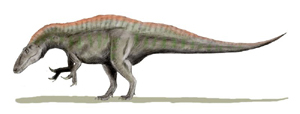
Phylum: Chordata Haeckel, 1874
Subphylum: Vertebrata Cuvier, 1812
Classe: Dinosauria Owen, 1841
Ordine: Saurischia Seeley, 1887
Famiglia: Carcharodontosauridae Stromer, 1931
Genere: Acrocanthosaurus Stovall & Langston, 1950
Descrizione
Come molti generi di dinosauri, Acrocanthosaurus contiene un'unica specie, A. Atokensis. I suoi resti fossili sono stati ritrovati principalmente negli stati dell'Oklahoma e del Texas, sebbene le zanne attribuite all'Acrocanthosaurus siano state rinvenute nella parte orientale del Maryland. Acrocanthosaurus era predatore bipede. Come suggerisce il nome, è soprattutto noto per l'altezza della sua spina dorsale, che molto probabilmente manteneva una sporgenza muscolosa oltre la schiena, il collo ed i fianchi dell'animale. Acrocanthosaurus era uno dei teropodi più grandi, era infatti lungo circa 12 metri e pesava più di 6 tonnellate. Alcune grandi impronte rinvenute in Texas potrebbero essere state lasciate dall'Acrocanthosaurus, nonostante non ci sia una corrispondenza diretta con la forma ossea. Recenti scoperte hanno portato alla luce più dettagli circa la sua anatomia, permettendo tramite studi specializzati di rilevare la forma del suo cervello e la funzione degli arti. Comunque è ancora aperto un dibattito a proposito dei suoi rapporti evoluzionari, poiché mentre alcuni scienziati lo classificano come allosauro, altri ritengono sia un carcarodontosauride. Acrocanthosaurus, come già detto, era il più imponente teropode del proprio ecosistema e probabilmente un super-predatore che probabilmente si cibava soprattutto di sauropodi ed ornitopodi. Malgrado fosse leggermente più piccolo di alcuni rettili come il Giganotosaurus, Acrocanthosaurus è stato uno dei maggiori teropodi mai esistiti. L'individuo maggiore da noi conosciuto misurava infatti 12 metri di lunghezza dalla testa alla punta della coda e pesava secondo le stime circa 6,2 tonnellate.
Diffusione
Genere di dinosauri teropodi diffuso nell'attuale Nordamerica durante i periodi dell'Aptiano e del primo Albiano agli inizi del Cretaceo.
Bibliografia
–Acrocanthosaurus atokensis, a new genus and species of Lower Cretaceous Theropoda from Oklahoma". American Midland Naturalist. 43 (3): 696-728.
–Bates, K.T.; Manning, P.L.; Hodgetts, D.; Sellers, W.I. (2009). Beckett, Ronald (ed.). "Estimating Mass Properties of Dinosaurs Using Laser Imaging and 3D Computer Modelling".
–Therrien, F.; Henderson, D.M. (2007). "My theropod is bigger than yours…or not: estimating body size from skull length in theropods" (PDF). Journal of Vertebrate Paleontology. 27 (1): 108-115.
–Currie, Philip J.; Carpenter, Kenneth (2000). "A new specimen of Acrocanthosaurus atokensis (Theropoda, Dinosauria) from the Lower Cretaceous Antlers Formation (Lower Cretaceous, Aptian) of Oklahoma, USA". Geodiversitas. 22 (2): 207-246. Archived from the original on November 14, 2007.
–Holtz, Thomas R.; Molnar, Ralph E.; Currie, Philip J. (2004). "Basal Tetanurae". In Weishampel, David B.; Dodson, Peter; Osmólska, Halszka (eds.). The Dinosauria (Second ed.). Berkeley: University of California Press. Pp. 71-110. ISBN 978-0-520-24209-8.
–Molnar, Ralph E.; Kurzanov, Sergei M.; Dong Zhiming (1990). "Carnosauria". In Weishampel, David B.; Dodson, Peter; Osmólska, Halszka (eds.). The Dinosauria (First ed.). Berkeley: University of California Press. Pp. 169-209. ISBN 978-0-520-06727-1.
–Harris, Jerald D. (1998). "A reanalysis of Acrocanthosaurus atokensis, its phylogenetic status, and paleobiological implications, based on a new specimen from Texas". New Mexico Museum of Natural History and Science Bulletin. 13: 1-75.
–Naish, Darren; Hutt, Stephen; Martill, David M. (2001). "Saurischian Dinosaurs 2: Theropods". Dinosaurs of the Isle of Wight. London: The Palaeontological Association. Pp. 242-309. ISBN 978-0-901702-72-2.
–Brusatte, Stephen L.; Benson, Roger B. J.; Chure, Daniel J.; Xu, Xing; Sullivan, Corwin; Hone, David W. E. (2009). "The first definitive carcharodontosaurid (Dinosauria: Theropoda) from Asia and the delayed ascent of tyrannosaurids" (PDF). Naturwissenschaften. 96 (9): 1051-8.
–Benson, Roger B. J.; Carrano, Matthew T.; Brusatte, Stephen L. (2009). "A new clade of archaic large-bodied predatory dinosaurs (Theropoda: Allosauroidea) that survived to the latest Mesozoic" (PDF). Naturwissenschaften. 97 (1): 71-8.
–Romer, Alfred S. (1956). Osteology of the Reptiles. Chicago: University of Chicago Press. P. 772pp. ISBN 978-0-89464-985-1.
–Walker, Alick D. (1964). "Triassic reptiles from the Elgin area: Ornithosuchus and the origin of carnosaurs". Philosophical Transactions of the Royal Society of London. Series B, Biological Sciences. 248 (744): 53-134. Bibcode: 1964RSPTB.248…53W.
–Romer, Alfred S. (1966). Vertebrate Paleontology (Third ed.). Chicago: University of Chicago Press. P. 468pp. ISBN 978-0-7167-1822-2.
–Carroll, Robert L. (1988). Vertebrate Paleontology and Evolution. W.H. Freeman and Company. ISBN 978-0-7167-1822-2.
–Lambert, David; Diagram Group (1983). "Spinosaurids". A Field Guide to Dinosaurs. New York: Avon Books. Pp. 84-85. ISBN 978-0-380-83519-5.
–Norman, David B. (1985). "Carnosaurs". The Illustrated Encyclopedia of Dinosaurs: An Original and Compelling Insight into Life in the Dinosaur Kingdom. New York: Crescent Books. Pp. 62-67. ISBN 978-0-517-46890-6.
–Glut, Donald F. (1982). The New Dinosaur Dictionary. Secaucus, NJ: Citadel Press. Pp. 39, 48. ISBN 978-0-8065-0782-8.
–Paul, Gregory S. (1988). "Genus Acrocanthosaurus". Predatory Dinosaurs of the World. New York: Simon & Schuster. Pp. 314-315. ISBN 978-0-671-61946-6.
–Olshevsky, George (1991). A Revision of the Parainfraclass Archosauria Cope, 1869, Excluding the Advanced Crocodylia. San Diego: Publications Requiring Research. P. 196pp.
–Eddy, Drew R.; Clarke, Julia A. (2011). Farke, Andrew (ed.). "New Information on the Cranial Anatomy of Acrocanthosaurus atokensis and Its Implications for the Phylogeny of Allosauroidea (Dinosauria: Theropoda)".
–Novas, Fernando E. (2013). "Evolution of the carnivorous dinosaurs during the Cretaceous: The evidence from Patagonia". Cretaceous Research. 45: 174-215.
–Liddell, Henry George; Robert Scott (1980). Greek-English Lexicon, Abridged Edition. Oxford: Oxford University Press. ISBN 978-0-19-910207-5.
–Langston, Wann R. (1947). A new genus and species of Cretaceous theropod dinosaur from the Trinity of Atoka County, Oklahoma. Unpublished M.S. thesis. University of Oklahoma.
–Czaplewski, Nicholas J.; Cifelli, Richard L.; Langston, Wann R. Jr. (1994). "Catalog of type and figured fossil vertebrates. Oklahoma Museum of Natural History". Oklahoma Geological Survey Special Publication. 94 (1): 1-35.
–D'Emic, Michael D.; Melstrom, Keegan M.; Eddy, Drew R. (2012). "Paleobiology and geographic range of the large-bodied Cretaceous theropod dinosaur Acrocanthosaurus atokensis". Palaeogeography, Palaeoclimatology, Palaeoecology. 333-334: 13-23. doi:10.1016/j.palaeo.2012.03.003.
–Ratkevich, Ronald P. (1997). "Dinosaur remains of southern Arizona". In Wolberg, Donald L.; Stump, Edward; Rosenberg, Gary (eds.). Dinofest International: Proceedings of a Symposium Held at Arizona State University. Philadelphia: Academy of Natural Sciences. ISBN 978-0-935868-94-4.
–Ratkevich, Ronald P. (1998). "New Cretaceous brachiosaurid dinosaur, Sonorasaurus thompsoni gen. Et sp. Nov., from Arizona". Journal of the Arizona-Nevada Academy of Science. 31 (1): 71-82.
–Lipka, Thomas R. (1998). "The affinities of the enigmatic theropods of the Arundel Clay facies (Aptian), Potomac Formation, Atlantic Coastal Plain of Maryland". In Lucas, Spencer G.; Kirkland, James I.; Estep, J.W. (eds.). Lower and Middle Cretaceous Terrestrial Ecosystems. New Mexico Museum of Natural History and Science Bulletin 14. pp. 229-234.
–Harris, Jerald D. (1998). "Large, Early Cretaceous theropods in North America". In Lucas, Spencer G.; Kirkland, James I.; Estep, J.W. (eds.). Lower and Middle Cretaceous Terrestrial Ecosystems. New Mexico Museum of Natural History and Science Bulletin 14. pp. 225-228.
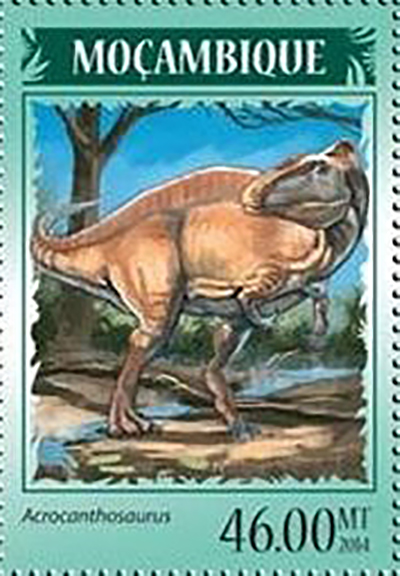
|
Data: 30/04/2014
Emissione: Dinosauri Stato: Mozambique Nota: Emesso in un foglietto di 4 v. diversi |
|---|
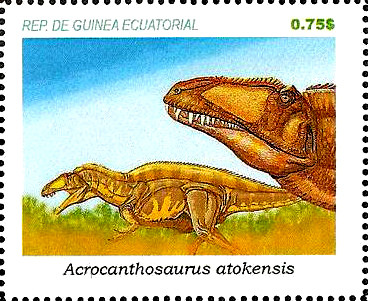
|
Data: 01/01/2009
Emissione: Animali preistorici Stato: Equatorial Guinea |
|---|
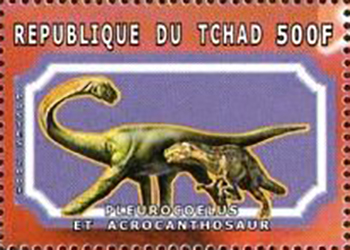
|
Data: 27/12/2001
Emissione: Animali preistorici Stato: Chad |
|---|

|
Data: 01/09/1999
Emissione: Dinosauri Stato: Grenada |
|---|
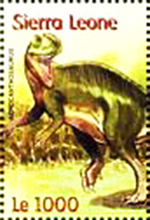
|
Data: 01/03/2001
Emissione: Mostra filatelica internazionale Hong Kong 2001 Stato: Sierra Leone Nota: Emesso in un foglietto di 8 v. diversi |
|---|
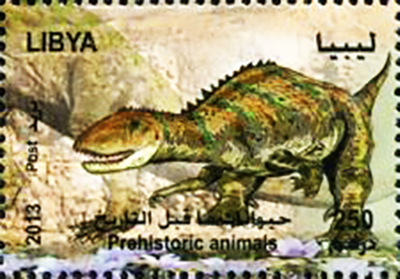
|
Data: 11/12/2013
Emissione: Animali preistorici Stato: Great Socialist People's Libyan Arab Jamahiriya |
|---|
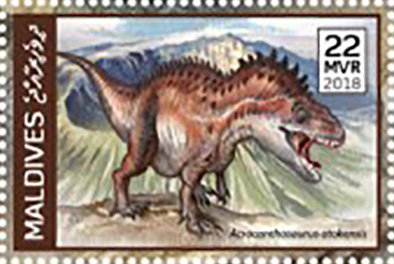
|
Data: 10/05/2018
Emissione: Dinosauri Stato: Maldives Nota: Emesso in un foglietto di 4 v. diversi |
|---|